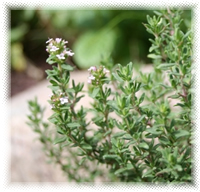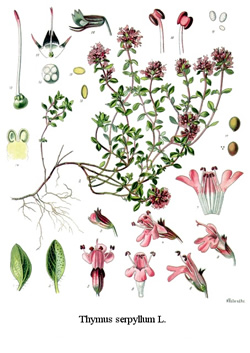Thyme Thymus vulgaris

Thyme in the garden
- Common Names
- Thyme , Common Thyme, Wild Thyme
- Botanical Name
- Thymus vulgaris
- Family
- LAMIACEAE
Medicinal Uses & Benefits of Thyme
![]() How to Use|
Side Effects |
Plant & Garden|
Aromatherapy Oil |
Folklore
How to Use|
Side Effects |
Plant & Garden|
Aromatherapy Oil |
Folklore
- Medicinal Uses: * Aromatherapy
* Congestion
* Cough
* Culinary/Kitchen
* Cuts & Wounds
* Dental/Oral Care
* Facial Care
* Herbal Steam
* Herbal Teas
* Insect Repellent
- Properties: * Analgesic * Antibacterial * Antifungal * Antioxidant * Antispasmodic * Antitussive * AntiViral * Aromatic * Breath * Depurative * Digestive * Expectorant * Insect repellents * Mental Clarity * Midsummer * Mood * Nervine * Vermifuge * Warm
- Parts Used: Leaves, stems and flowers
- Constituents: thymol and carvacrol, rosmarinic acid
How to Use: Thyme
Thyme is another member of the venerable Lamiaceae, the mint family, that has been used since the earliest times as a medicinal herb.
“The antiseptic properties of Thyme were fully recognized in classic times, there being a reference in Virgil’s Georgies to its use as a fumigator, and Pliny tells us that, when burnt, it puts to flight all venomous creatures.” (Grieve, Maud)Thyme is one of the best herbs to use as a cough and cold remedy, addressing all your cold symptoms in a holistic way. Thyme acts both as an expectorant to clear the lungs of congestion and as a antitussive, calming coughing spasms.White, Linda B. M.D. Thyme tea will settle the stomach, help you sleep, soothe a sore throat, relieve aches and pains, and encourage your body to sweat, helping to eliminate toxins and bring down a fever. Drinking a warm thyme tea sweetened with thyme honey is a pleasant and tasty way to get these benefits. Thyme essential oil can also be used in room diffusers. This long list of medicinal actions is attributed mainly to the essential oil components, thymol and carvacrol which are highly antiseptic. Thyme oil can be used to treat cuts and wounds to prevent and treat infections when diluted with a carrier oil. (Hoffmann, David, 589)
Preparation Methods & Dosage :Thyme leaf is a healthy culinary herb, and makes a pleasant tea. Place sprigs of thyme among clothes or linens to dispel musty odors and deter insect pests. Both the leaves and flowers can be used to stuff sachets.
Thyme Remedies
Thyme : Essential Oil Profile
Spicy-herbaceous, sweet, medicinal scent. Use with caution, can be very irritating to skin. The concentrated essential oil is a powerful disinfectant. Blend with sage and use in steam inhalation treatments for bronchitis.
- Anticellulite Bath Synergistic Blends
- Boil Treatment
- Dry cough chest rub
- Head Lice Treatment
- Thyme-Lemon Disinfectant Spray
- Thyme and Peppermint mouthwash
- Sore Muscle Balm
- Thyme and Sage Respiratory blend
Thyme Side Effects: Generally considered safe, excessive amounts can effect menstrual cycles. When isolated from the rest of the plant the thymol is toxic and should be used with great care and in moderation. The essential oil should never be applied undiluted and is not suitable for use in animals or small children.
Plant Description

Koehler's Medicinal-Plants 1887
T. vulgaris is a perennial with a woody, fibrous root. The stems are numerous, round, hard, branched, and usually from 4 to 8 inches high, when of the largest growth scarcely attaining a foot in height. The leaves are small, only about 1/8 inch long and 1/16 inch broad, narrow and elliptical, greenish-grey in colour, reflexed at the margins, and set in pairs upon very small foot-stalks. The flowers terminate the branches in whorls.
The plant has an agreeable aromatic smell and a warm pungent taste. The fragrance of its leaves is due to an essential oil, which gives it its flavouring value for culinary purposes, and is also the source of its medicinal properties. It is in flower from May to August.
Regional Traditions :European *
How to Grow Thyme
According to legend, any place where thyme grows wild is a place blessed by the fairies so perhaps you can coax some magical visitors into your garden. Thyme has been a garden staple, since time out of mind and was a must have for colonial gardens as this herb filled so many needs, John Josselyn noted its profusion in his New England diaries. Thymus is a heavily populated genus with some 350 species most being aromatic, evergreen woody perennials. There is such wide variation between leaf and flower color, and growth habits, some creeping, some upright, that it won't be hard to find a suitable space in the garden. The warm, pungent aroma and taste of the tiny leaves are derived mainly from the essential oil containing thymol and carvacrol, and rosmarinic acid.
History and Traditions & Folklore
The name thyme is derived from the Greek thumos, as identical with the Latin fumus- smoke, having reference to the ancient use of Thyme in sacrifices, because of its fragrant odour; or, it may be, as signifying courage (thumos), which its cordial qualities inspire. With the Greeks Thyme was an emblem of bravery, and activity; also the ladies of chivalrous days embroidered on the scarves which they presented to their knights the device of a bee hovering about a spray of Thyme, as teaching the union of the amiable and the active. (Fernie, W.T. M.D.)
Thyme was a must have for colonial gardens as this herb filled so many needs, John Josselyn noted its profusion in his New England diaries.
According to legend, any place where thyme grows wild is a place blessed by the fairies. The ancient Greeks burned thyme in their temples for consecration and purification, but also as an offering to the gods. It was especially sacred to Adephaghia, the Greek goddess of food and good eating. Modern pagans use thyme as a smudging herb to purify the space used for a magical ritual. Wear sprig of thyme in your hair to make yourself irresistible. A pillow stuffed with thyme dispels nightmares and promotes safe, positive dreams.Wild thyme was sacred to Freyja (Freya), a Norse pagan goddess, and was placed in the pillows of the sickbed. Claudia Muller-Ebeling, Wolf-Deieter Storl. Witchcraft Medicine, Inner Traditions (1998)











